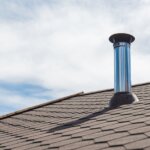Class F – Flue for a micro combined heat and power on residential
 Whilst you do not need planning permission for a micro combined heat and power system, you will need an external flue for the boiler.
Whilst you do not need planning permission for a micro combined heat and power system, you will need an external flue for the boiler.
Micro combined heat and power (micro-CHP) is a technology that generates heat and electricity simultaneously, from the same energy source, in individual homes or buildings. The main output of a micro-CHP system is heat, with some electricity generation, at a typical ratio of about 6:1 for domestic appliances.
A typical domestic system will generate up to 1kW of electricity once warmed up. The amount of electricity generated over a year depends on how long the system is able to run.
For residential properties or blocks of flats, this is covered under Class F of Part 14. You will not need planning permission.
As long as the flue does not extend more than 1 metre above the highest point of the roof or in the case of a conservation area or world heritage site isn’t on a wall or roof slope facing a highway you are fine.
Apart from these two minor restrictions on a flue for a micro combined heat and power heating system you can crack on.
If you are in a listed building, you will need listed building consent.
For the commercial version of this, please see Class O of Part 14.
Legislation
Class F – installation or alteration etc of flue for combined heat and power on domestic premises
Permitted development
F. The installation, alteration or replacement of a flue, forming part of a microgeneration combined heat and power system, on a dwellinghouse or a block of flats.
Development not permitted
F.1 Development is not permitted by Class F if—
(a) the height of the flue would exceed the highest part of the roof by 1 metre or more; or
(b) in the case of land within a conservation area or which is a World Heritage Site, the flue would be installed on a wall or roof slope which fronts a highway.
Page Updated: 4th March 2023



